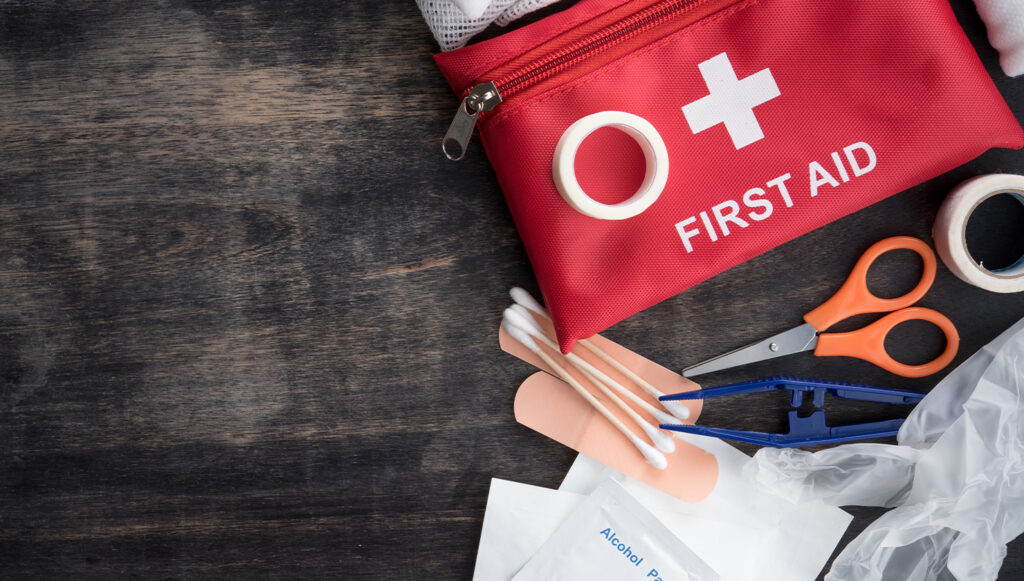
It is crucial to know first aid and how to apply that knowledge in case of an emergency. You can save someone’s life that way! How well do you know first aid? Take the quiz we have for you and learn for yourself.
Not sure about your score? Keep reading for some basic information on what first aid is and what should your actions be in case of various emergencies.
First aid means the emergency care that should be provided to a person who is injured or ill until full medical treatment is available. In some cases, first aid can be enough. For more serious problems, it’s meant as a temporary aid until paramedics arrive or until a hurt person gets taken to the hospital.
Making the right decision in an emergency can mean the difference between life and death. When you approach the individual who is injured or ill, you should introduce yourself and explain that you are a first aid provider and are willing to help. Do not touch the person before they agreed to it – they must give you their permission to help them. However, if you encounter someone who is visibly confused or critically injured, or sick, you can assume they would want help and proceed with first aid.
The first step in providing aid should be to call 911 or your local Emergency Medical Services number. If you aren’t sure how serious the situation is and what should you do, the 911 responder will ask questions to evaluate the severity of the situation. They can also guide you through performing CPR or providing basic care until help arrives.
Whether you are at home, work, or school, you should be aware of where the first aid kit is, as well as AED (automated external defibrillator). You should also know their contents and how to use them. What should a basic first aid kit contain? Common items found in it are bandages, sterile gauze, antiseptic wipes, absorbent compresses, and a mask for breathing (for rescue breathing or CPR). Consider purchasing a commercially available first aid kit to keep at your home.
Once you recognize the problem and call for help, you should determine how responsive the injured/sick individual is. The best way to do this is to tap the person and talk loudly to them: “Are you okay?” After determining responsiveness, yell for help. Look for any medical identifications, such as a necklace or a bracelet. This may provide a valuable clue to the cause of the situation.
You should be cautious while approaching the scene of an emergency, for example, a car accident. You don’t want to become another person hurt. Look for any potential dangers, and remove the person from them.
When someone is unconscious or unresponsive, a basic principle of first aid is ABC.
A means Airway – if the person is not breathing, clear their airway.
B is for Breathing – if their airway is cleared and they still aren’t breathing, provide rescue breathing.
C is for Circulation – perform chest compressions to keep blood circulating, as well as rescue breathing. If the person is breathing but unresponsive, check their pulse. If their heart has stopped, provide chest compressions.
There is also a simpler version of the ABCs, which goes like that:
Awake? If the person is not awake, try to wake them. If they don’t wake up, call 911 or have someone do it and move on to B.
Breathing? If they aren’t, perform rescue breathing and chest compressions. If so, move on to C.
Continue care: that means you should continue treatment until an ambulance arrives, or do what the 911 operator directs you to do.
Cardiopulmonary resuscitation, or CPR, is one of the most important emergency medical procedures. If an individual is in cardiac arrest, where their heart is not beating, they could die. Performing CPR could save their life.
What to do if you suspect someone is in a cardiac arrest? First, get someone to call 911. Next, check if the person’s mouth and throat are clear. Remove any obvious blockages in their mouth and nose, such as blood or broken teeth, then gently tilt their head back and lift their chin.
After, start chest compressions immediately. Kneel beside the patient and place them on their back. Place the heel of your hand in the center of the person’s chest on the lower half of the breastbone. Interlock your fingers and place your other hand on top of the first, and place yourself above the patient’s sternum. Using your body weight and keeping your arms straight, press one-third of the way down on their chest. Then, release the pressure. Pressing down and releasing counts as one compression.
If you want to perform rescue breathing, make sure the person’s airway is clear, tilt their head back and lift the chin. Next, pinch the soft part of the nose closed with your index finger and thumb. Then, open the person’s mouth with your thumb and fingers. Take a breath and place your lips over the patient’s mouth, ensuring a good seal, and blow steadily into their mouth for about one second, watching for the chest to rise. Allow air to exit before giving the next breath.
First aid is very important. Are you ready to prove how much you know about first aid? Take the quiz and get your score now! Good luck with your results.
How many questions are in the quiz?
There are 20 questions.
What score can you get?
Up to 20 points.
